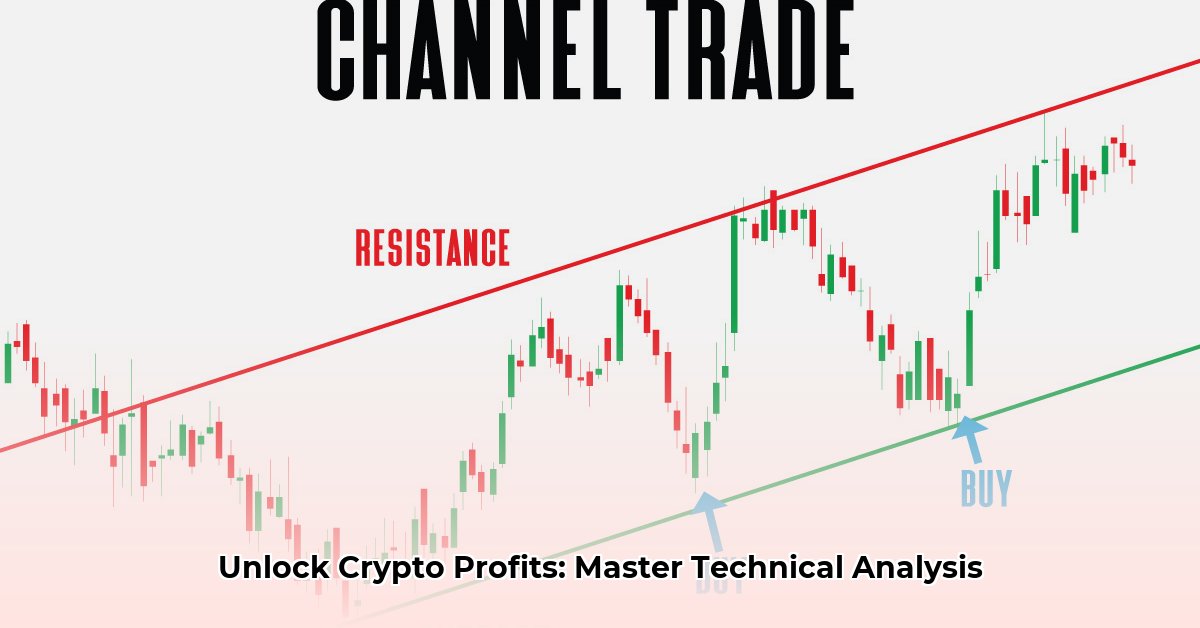Crypto trading can feel like navigating a minefield, doesn’t it? This instructional guide provides a clear path using technical analysis – reading charts – to enhance your cryptocurrency trading strategy. We’ll demystify the essential tools, strategies, and common errors, offering practical advice for improved decision-making, whether you’re a beginner or an experienced trader. For real-time data, check out these live crypto quotes.
Technical Analysis for Crypto Quotes
Cryptocurrency trading’s volatility can be intimidating. Technical analysis (TA) offers a structured methodology to interpret market behavior and improve your trading decisions. While not foolproof, TA equips you with the tools to make more informed choices and manage risk effectively. How can technical analysis help you navigate the volatile crypto landscape?
Deciphering the Crypto Market: The Basics of Technical Analysis
Technical analysis involves analyzing historical price and volume data to identify potential future price movements and cryptocurrency market trends. Rather than predicting the future, TA seeks to recognize likely scenarios based on recurring patterns. It’s akin to using weather patterns to forecast the chance of rain—not a certainty, but a helpful indicator.
Charts illustrating a cryptocurrency’s price history often reveal recognizable patterns. For example, the “head and shoulders” pattern frequently suggests a potential price reversal. Technical indicators, such as Moving Averages, Relative Strength Index (RSI), Moving Average Convergence Divergence (MACD), Bollinger Bands, and On-Balance Volume (OBV), offer supplementary insights into market momentum, volatility, and potential overbought or oversold conditions, and crypto market cycles.
Getting Started: Essential Indicators for Beginners
Start with fundamental indicators. Moving averages smooth out price fluctuations, highlighting broader trends. The Relative Strength Index (RSI) identifies when a cryptocurrency is overbought (likely to decrease in value) or oversold (likely to increase). The Moving Average Convergence Divergence (MACD) signals shifts in a cryptocurrency’s momentum. Mastering these tools forms a solid foundation for informed trading decisions and risk management.
Interpreting this data requires ongoing practice. Start with the basics and gradually incorporate more advanced techniques to refine your analytical skills.
Reading the Crypto Tea Leaves: A Step-by-Step Guide to Chart Analysis
Here’s a step-by-step approach to analyzing a crypto chart effectively and employing technical analysis strategies for profit:
-
Choose Your Chart Type: Candlestick charts visually represent price movements over time, displaying opening, closing, high, and low prices for each period. Each “candle” provides a snapshot of buying and selling pressure within that timeframe. Green candles indicate the price closed higher than it opened, suggesting bullish sentiment, while red candles indicate the price closed lower, suggesting bearish sentiment. The “wicks” or shadows extending from the candle represent the highest and lowest prices reached during that interval.
-
Select Your Indicators: Initially, concentrate on moving averages (simple or exponential), RSI, and MACD. Avoid overwhelming yourself with too many indicators; focus on mastering a few key tools. A simple moving average (SMA) calculates the average price over a specified period, giving equal weight to each data point. An exponential moving average (EMA) gives more weight to recent prices, making it more responsive to current market conditions. Experiment and see which best complements your trading style.
-
Identify the Trend: Determine whether the price is generally trending upwards (uptrend), downwards (downtrend), or sideways (sideways trend). This trend forms the basis for your analysis. Uptrends are characterized by higher highs and higher lows, downtrends by lower highs and lower lows. Sideways trends, also known as consolidation phases, show the price moving within a relatively narrow range.
-
Spot Recognizable Patterns: Identify common chart patterns like head and shoulders, double tops/bottoms, triangles, or flags. These patterns can suggest probable shifts in price direction. Treat them as clues, not guarantees. The head and shoulders pattern, for example, often signals a bearish reversal after an uptrend. Double tops and bottoms can indicate resistance or support levels, respectively. Triangles can suggest continuation or reversal patterns, depending on the context.
-
Confirm with Indicators: Verify that your chosen indicators support the identified trend and patterns. For example, does a downtrend correspond with an RSI reading indicating an oversold condition? Consistent analysis strengthens your confidence. If the price is trending upward, look for the RSI to stay above 30, confirming bullish momentum. If you spot a potential head and shoulders pattern, see if the MACD confirms the bearish divergence.
-
Set Your Risk Tolerance: Define the maximum amount you’re willing to lose before initiating any trade. Implement stop-loss orders to automatically sell if the price falls below a set level. Similarly, use take-profit orders to automatically sell when the price reaches your desired target. A common strategy is to place your stop-loss order just below a key support level or above a recent high. Your take-profit order should be based on your risk/reward ratio and potential resistance levels.
-
Analyze Across Timeframes: Examine daily, weekly, and monthly charts in addition to short-term charts (e.g., hourly data) for a comprehensive perspective. A significant drop on an hourly chart may appear minor within a long-term uptrend. Analyzing multiple timeframes helps you filter out noise and identify stronger, more reliable signals. For instance, a bullish pattern on a daily chart carries more weight than the same pattern on a 15-minute chart.
-
Backtest Your Strategy: Evaluate your analysis using historical data before risking real capital. This process allows you to refine your approach and identify potential weaknesses. Backtesting involves applying your trading rules to past market data to see how they would have performed. This gives you insights into the potential profitability and risk of your strategy.
Remember that TA is only one aspect for how to approach crypto trading. Integrate fundamental analysis (examining the cryptocurrency’s technology and adoption), news, and market sentiment for a well-rounded perspective.
Diving Deeper: Understanding Key Technical Indicators
Let’s explore some of the most popular technical indicators in more detail:
-
Moving Averages (MA): These smooth out price data to create a single flowing line, making it easier to identify trends. There are simple moving averages (SMA) and exponential moving averages (EMA).
-
Relative Strength Index (RSI): This momentum oscillator measures the speed and change of price movements, ranging from 0 to 100. Readings above 70 suggest overbought conditions, while readings below 30 indicate oversold conditions.
-
Moving Average Convergence Divergence (MACD): This trend-following momentum indicator shows the relationship between two moving averages of prices.
-
Bollinger Bands (BB): These bands plot two standard deviations above and below a moving average. When prices touch the upper band, the asset may be overbought; when prices touch the lower band, the asset may be oversold.
-
On-Balance Volume (OBV): This momentum indicator uses volume flow to predict changes in stock price.
Level Up: Advanced Techniques and Considerations
Once comfortable with the basics, consider more advanced techniques, such as algorithmic trading, which involves combining TA with automated trading systems. While offering increased efficiency, it also introduces greater complexity and risk.
Elliott Wave Theory is one such advanced technique. This theory suggests that market prices move in specific patterns called waves. Identifying these waves can help traders predict future price movements, but it requires considerable skill and experience.
Fibonacci Retracements are another tool used to identify potential support and resistance levels. They are based on the Fibonacci sequence and can help traders pinpoint areas where the price might reverse.
It’s crucial to understand that TA isn’t infallible. Some argue that the Efficient Market Hypothesis (EMH) suggests price movements are largely random and unpredictable, making consistent profits through technical analysis impossible, and is one of the major cryptocurrency market risks. This hypothesis’s validity and its impact on TA remain subjects of ongoing debate and research.
Managing Risk: The Unsung Hero of Crypto Trading
Effective risk management is essential. Never invest more than you can afford to lose. Employ stop-loss orders to minimize potential losses. Diversify across multiple cryptocurrencies to mitigate the impact of any single currency’s price movement. Continuous learning and adaptation to market dynamics are crucial for long-term success. What risk management strategies are most effective in the volatile cryptocurrency market?
Consider these risk management techniques:
-
Calculate Your Risk/Reward Ratio: Aim for trades where the potential reward is at least two to three times greater than the risk.
-
Use Trailing Stop-Loss Orders: These orders automatically adjust the stop-loss level as the price moves in your favor, locking in profits while limiting potential losses.
-
Regularly Rebalance Your Portfolio: This involves selling some of your holdings that have performed well and buying more of those that have underperformed to maintain your desired asset allocation.
-
Stay Informed About Market News and Events: Monitor regulatory changes, technological developments, and other factors that could impact the cryptocurrency market.
Weighing the Pros and Cons: A Balanced View of Technical Analysis
| Pros | Cons |
|---|---|
| Helps identify potential entry and exit points | Subjective interpretation of patterns can lead to errors |
| Useful for gauging market momentum | Can generate “false signals,” leading to incorrect trades |
| Aids in risk management | Not a foolproof means of predicting future price shifts |
| Applicable to various cryptocurrencies | Effectiveness depends greatly on |
- Uncover Timeless Ancient Greece Female Names: A Guide to Choosing the Perfect Name - August 9, 2025
- Explore Ancient Greece Artifacts: Unveiling Iconic Treasures - August 9, 2025
- Unveiling Ancient Greek Marriage: Customs & Laws Revealed - August 9, 2025
















